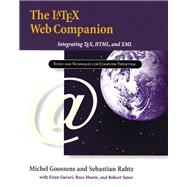
Michel Goossens is past president of the TeX Users Group. A research physicist at CERN, where the Web paradigm was born, he is responsible for LaTeX, HTML, SGML, and, more recently, XML support for scientific documents.
Sebastian Rahtz is Past Secretary of TUG, a cofounder of CTAN, creator of the TeX Live CD-ROM, and a co-author of The LaTeX Graphics Companion. He is an IT analyst at Elsevier Science Ltd.
Eitan Gurari, Ross Moore, and Robert Sutor are, respectively, the principal architects of TeX4ht, LaTeX2HTML, and techexplorer.
Eitan Gurari, Ross Moore, and Robert Sutor are, respectively, the principal architects of TeX4ht, LaTeX2HTML, and techexplorer.
Eitan Gurari, Ross Moore, and Robert Sutor are, respectively, the principal architects of TeX4ht, LaTeX2HTML, and techexplorer.
| List of Figures | |
| List of Tables | |
| Preface | |
| The Web, its documents, and LaTeX | |
| The Web, a window on the Internet | |
| The Hypertext Transport Protocol | |
| Universal Resource Locators and Identifiers | |
| The Hypertext Markup Language | |
| LaTeX in the Web environment | |
| Overview of document formats and strategies | |
| Staying with DVI | |
| PDF for typographic quality | |
| Down-translation to HTML | |
| Java and browser plug-ins | |
| Other LaTeX-related approaches to the Web | |
| Is there an optimal approach? Conclusion | |
| Portable Document Format | |
| What is PDF? Generating PDF from TeX | |
| Creating and manipulating PDF | |
| Setting up fonts | |
| Adding value to your PDF | |
| Rich PDF with LaTeX: The hyperref package | |
| Implicit behavior of hyperref | |
| Configuring hyperref | |
| Additional user macros for hyperlinks | |
| Acrobat-specific commands | |
| Special support for other packages | |
| Creating PDF and HTML forms | |
| Validating form fields | |
| Designing PDF documents for the screen | |
| Catalog of package options | |
| Generating PDF directly from TeX | |
| Setting up pdfTeX | |
| New primitives | |
| Graphics and color | |
| The LaTeX2HTML translator | |
| Introduction | |
| A few words on history | |
| Principles for Web document generation | |
| Required software and customization | |
| Running LaTeX2HTML on a LaTeX document | |
| Installation | |
| Customizing the local installation | |
| Extension mechanisms and LaTeX packages | |
| Mathematics modes with LaTeX2HTML | |
| An overview of LaTeX2HTMLs math modes | |
| Advanced mathematics with the math extension | |
| Unicode fonts and named entities, in expert mode | |
| HTML 4.0 and style sheets | |
| Large images and HTML 2.0 | |
| Future use of MathML | |
| Support for different languages | |
| Titles and keywords | |
| Character-set encodings | |
| Multilingual documents using babel | |
| Images using special fonts | |
| Converting transliterations using preprocessors | |
| Extending LaTeX sources with hypertext commands using the html package | |
| Hyperlinks to external documents | |
| Enhancements appropriate for HTML | |
| Alternative text for hyperlinks | |
| Conditional environments | |
| Navigation and layout of HTML pages | |
| Example of linking various external documents | |
| Advanced features | |
| Translating LaTeX to HTML using TeX4ht | |
| Using TeX4ht | |
| Package options | |
| Picture representation of special content | |
| A complete example | |
| Manual creation of hypertext elements | |
| Raw hypertext code | |
| Hypertext pages | |
| Hypertext links | |
| Cascading Style Sheets | |
| How TeX4ht works | |
| From LaTeX to DVI | |
| From DVI to HTML | |
| Other matters | |
| Extended customization of TeX4ht | |
| Configuration files | |
| Tables of contents | |
| Parts, chapters, sections, and so on | |
| Defining sectioning commands | |
| Lists | |
| Environments | |
| Tables | |
| Small details | |
| The inner workings of TeX4ht | |
| The translation process | |
| Running LaTeX | |
| Running the tex4ht program | |
| A look at t4ht | |
| From DVI to GIF | |
| A taste | |
| Table of Contents provided by Publisher. All Rights Reserved. |
The New copy of this book will include any supplemental materials advertised. Please check the title of the book to determine if it should include any access cards, study guides, lab manuals, CDs, etc.
The Used, Rental and eBook copies of this book are not guaranteed to include any supplemental materials. Typically, only the book itself is included. This is true even if the title states it includes any access cards, study guides, lab manuals, CDs, etc.